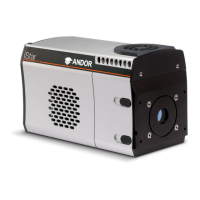Appendix
MICRO CHANNEL PLATE (MCP)
The MCP is a thin disk (~1mm) of honeycomb glass. Each of the ~10 µm honeycomb channels is coated with a resistive
material.
The MCP plate has a high potential across it (500V to 1kV) so that an incoming photoelectron will cascade down the
channel, producing secondary electrons by impact ionization. Typical gain for single stage MCP can be as high as 104
– gain can be adjusted by varying the voltage potential across the MCP. This is typically achieved through a software-
controlled DAC in research-grade Intensied CCDs.
Figure X: Amplication in one channel
Figure X: Microchannel Plate (MCP)
PHOSPHORS
The function of the Phosphor on the inside of the intensier’s ber optic exit window is to convert the incident electron
pattern into a visible light pattern that can be detected by the CCD. For best efciency, it is important that the emission
of the phosphor is matched to the response of the CCD.
PHOSPHOR TYPE COLOR EMISSION PEAK (NM) DECAY TIME
(TO 10%)
COMPOSITION RELATIVE LIGHT
OUTPUT
P46 Yellow/Green 530 200 ns Y
3
Al
5
O
12
:Ce 10
P43 Yellow/Green 545 2 ms Gd
2
O
2
S:Tb 100
Our systems use either P46 or P43 Phosphor as standard (details are shown in the table above). P46 is used
for applications requiring fast scan rates (> 100 Hz). If these speeds are not required then the more efcient P43
is preferable. P43 is used in preference to the more commonly used P20 because of superior linearity. See the
specication supplied with your system for more details.
COUPLING TO THE SENSOR
The output of the image intensier is coupled to a sensor via either a lens - with possible vignetting and lower
throughput, or a bre-optic plate for low distortion and maximum throughput. The high efciency bre optic coupling
in the New iStar is important because it means that the image intensier can be operated at lower gains, which results
in better dynamic range and linearity. This is why ICCDs have replaced Intensied Photodiode Arrays (IPDAs) as the
detector of choice.
Fibre-optics plate can be tapered to best match the image intensier aperture size (typically Ø18 or 25 mm for Intensied
CCDs) to the CCD size.

